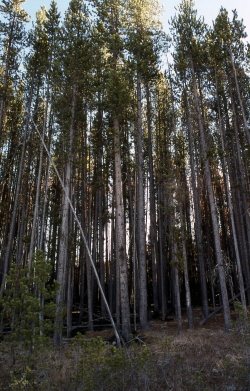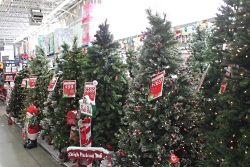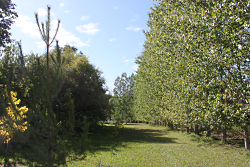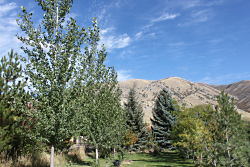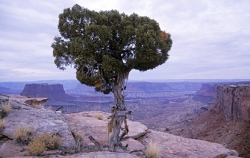
Drawing water from a stone: this juniper grew out of just a few fractures in the surface rock.
Courtesy US NPS, Neal Herbert, Photographer
When I go outside, breathe in the thick charcoal air, see the dribbling water in the once-mighty streams, and hear more stories of growing sickness, I’ll admit that I have doubts which edge on fear. I doubt that this is the last year of record-breaking heat. I doubt that this is the last year of record-breaking drought. I doubt that this is the last year of record-breaking hospitalizations. Such doubt can make you feel hopeless, powerless, and just plain sad. What have we done? How did we get here? Wasn’t this all avoidable? It takes me some time, then, to remember to move on from that doubt and to take a path, but to never forget the place in which drove me to rest and reflect. Though it can feel like a good place of respite, a shady tree to rest one’s laurels or wallow and say uncle to what we’ve sown, there’s still work which can be done. To rest in doubt is to be a bump on a log and not the tree itself. I remember the lessons of the humble tree.
The tree lives because of doubt’s prodigy of conjoined fear and hope. We must also harness both in equal form and measure in order to grow, and to live. In seeing the unified balance there is motion. The tree’s roots reach downwards, clinging to the earth in fear. In this way the world is its. The tree’s branches reach skywards, opening to the sky in hope. In this way it is the world’s. The tree’s roots drink water and move the earth: from fear comes motion and matter. The tree’s leaves drink fire and move the air: from hope comes life and form. Without fear, we would shrivel. Without hope, we would rot. Without fear, we would fall. Without hope, we would suffocate. To be subject to hope, you must make fear a part of you. Latch onto it, and feel that this shade of love is life given purpose. Then you may reach upwards and see that you do so only because you contain that which you cling to.
The fear I feel when I breathe in our Utah air, see green lawns, and hear new numbers on the radio is necessary for hope, and both are only possible because of the blessings of doubt because the future is not fixed. And yet, there is another hidden secret to fear and hope, and that is action. The tree is not a static being. Like all of us, it is in a constant state of becoming. We may be where we are, but where we are does not mean we must remain. Trees grow over boulders, thrive upon cliffs, and so can we. We can move on from La Brean doubt on what shall be. We can continue our journey in becoming. Given this, we then have a question in which to answer for ourselves: the question though is not what shall we become, but towards which light do we choose to work towards in equal measure to our fears?
I’m Patrick Kelly, and I’m Wild About Utah.
Credits:
Images: Courtesy US National Park Service, Neal Herbert, Photographer
Audio: Courtesy & © J. Chase and K.W. Baldwin. https://upr.org/
Text: Patrick Kelly, Director of Education, Stokes Nature Center, https://www.logannature.org
Included Links: Patrick Kelly & Lyle Bingham, Webmaster, WildAboutUtah.org
Additional Reading
Wild About Utah, Posts by Patrick Kelly
Stokes Nature Center in Logan Canyon, https://www.logannature.org/
The Indomitable Juniper, Canyonlands National Park, US National Parks Service, US Department of the Interior, https://www.nps.gov/cany/learn/nature/utahjuniper.htm (Image source)

